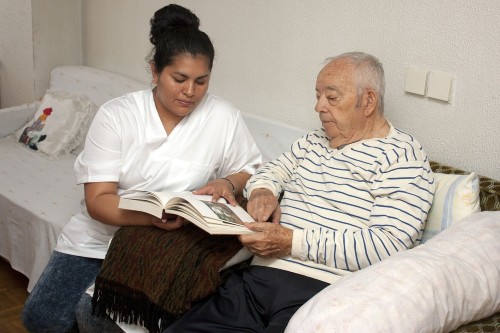Rapid Realist Review Uncovers Strategies for Achieving Effective Virtual Wards for People with Frailty
Proactive care, a whole-system approach and a ‘team-of-teams’ are important elements in achieving effective virtual wards for people with frailty, according to the first rapid realist review of the evidence. The findings of the National Institute of Health and Care Research (NIHR) funded review, published in Age and Ageing and involving University of Bristol researchers, also apply to multidisciplinary virtual wards for other complex conditions.
Rapid realist reviews aim to understand what makes a complex intervention, such as a virtual ward, work effectively in the real world, including how, why and for whom.
The review, by researchers from the NIHR Applied Research Collaboration West (NIHR ARC West) and the University of Bristol, identifies what parts or processes of a virtual ward help it to work well. The review explores how those components and different professionals can be brought together to assess, monitor and treat patients according to their individual needs.
As the population ages, more and more people are living with frailty. Traditional in-hospital models of care are unsustainable in this context. Frailty virtual wards allow patients at high risk of or experiencing a crisis to be safely cared for at home, rather than in hospital.
Frailty virtual wards enable remote planning of individual patient care by a multidisciplinary team of professionals, with care delivered by community and primary care teams. Virtual wards are increasingly used in the NHS.
The research team found 17 relevant academic papers and 11 documents from other sources, mainly local and regional NHS websites. They also engaged with patients, caregivers and clinicians.
The team identified two main virtual ward models for people with frailty:
- Short-term, acute wards (1-21 days) for patients already experiencing a frailty crisis (such as sudden immobility, delirium, severe falls)
- Longer-term care wards (more than 3 weeks, typically 3-7 months) offering proactive care to prevent a high-risk patient reaching crisis
The two types of virtual ward have different aims, such as how patients are selected and discharged to GP care. However, the patients are similar because of the nature of frailty. For example, a minor infection can quickly ‘tip’ a high-risk patient into crisis. Both types of virtual ward contributed to the findings, which in turn informed general implementation of virtual wards.
The rapid realist review identified three key themes:
- Building blocks for setting up a virtual ward and underpinning effective operation (information sharing, common standards, multidisciplinary team meetings, good co-ordination)
- Delivering the patient pathway, including proactive care
- Patient and caregiver experience and empowerment
The paper also reports factors and mechanisms in each theme for virtual wards to function effectively:
- The virtual ward operating as a ‘team-of-teams’
- Buy-in of professionals: the importance to them of patient safety and benefit, starting small, taking time to introduce formal agreements and learn new ways of working
- Good communication between patients, caregivers and staff
Evidence on some other factors was limited , including the sustainability of virtual wards, experiences of caregivers, and remote monitoring. The impact of social inequalities was not covered.
The review also identified situations where operating virtual wards may be more difficult. For example, if the home environment is not safe, or if a patient has delirium and the caregivers or family members cannot cope, especially outside virtual ward hours.
For virtual ward sustainability, a proactive approach is best. This includes identifying patients with frailty at high risk of a crisis and providing care to prevent crisis and stabilise frailty. Short-term acute reactive wards can work in tandem for people with frailty in-crisis, but here, continuity of care post-discharge is essential. A combination virtual ward may be optimal, caring both for those at high risk of a crisis and those in crisis.
The authors suggest that a whole system approach to frailty is needed, involving primary care and other place-based teams in selecting virtual ward patients and continuity of care after discharge.
Dr Maggie Westby, Senior Research Associate at ARC West and Bristol Medical School: Population Health Sciences (PHS) and lead author of the paper, said: “Our rapid realist review is the first to look at what constitutes a virtual ward and how those elements come together under one ‘virtual roof’ to deliver frailty interventions. This is vital information as virtual wards are being adopted across the NHS. We found empowering patients and caregivers and the value of preventative, whole-system approaches, were particularly important.
“With our ageing population, we need creative solutions to help people stay well at home for longer and reduce the impact on hospitals. Virtual wards are one possible solution, but how they are implemented and managed, and for whom, is key to them delivering the benefits policymakers are hoping for.”
Dr Hein Le Roux, GP and One Gloucestershire Integrated Care System (ICS) Quality Improvement Lead and Deputy Medical Director for NHS England South West, is another author. He said:
“From my experience, many patients often want to remain at home when unwell and avoid going into hospital. At the moment when someone is unwell, clinicians don’t always have a safe place other than an admission. The virtual ward development offers a safe alternative for the right cohort of patients.
“There are also system flow benefits. If some patients can be safely cared for at home, for those who do need to be escalated to hospital, there will be better access to ambulance services, emergency departments and ward beds. This will improve care for them.
“The delivery of virtual wards relies on a ‘team of teams’ approach which the ICS way of working supports. This also mirrors other developments in how ICSs deliver care, particularly around anticipatory and proactive care in our nascent integrated neighbourhood teams.”

